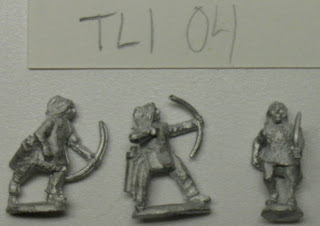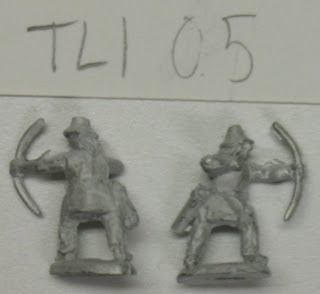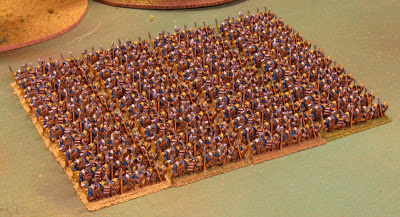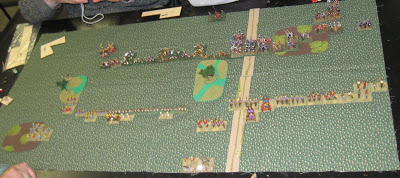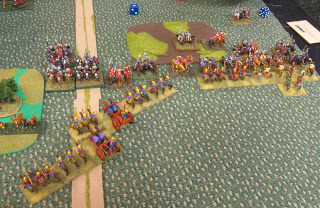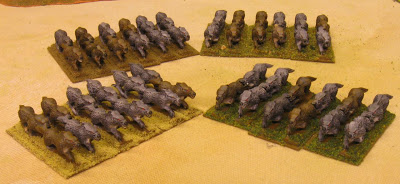I met JM at Legions this Friday, to play some DBA, and discovered a latent desire to play DBA in several other Legions gamers as well. They should really get out on a First Monday of the Month, since the Stooge crowd has other plans on Friday nights.
I arrived shortly after 9pm and waited for JM to finish up his Flames of War game while I tried to wake up… I really could’ve used a nap. I brought 5 armies so there would be plenty of different opponents, and ended up playing 4 games total. Unfortunately, I forgot to take any pictures while I was playing… I’m writing down my thoughts primarily so I’ll remember them.
In the first game, JM played II/12: Alexandrian Macedonians with the 4Ax option, against my II/7: Later Achaemenid Persians. I took my now-standard mix of 3x4Sp, 1x3Ax and 1x2Ps.
At this point I hadn’t waken up yet, and I don’t remember much of the game. But I do remember it was fairly tight, and I remember the pivotal event: I had my mounted force on my right flank, and I was able to surround Alexander (3Kn) on the front, one flank, and rear, for a +2 (or +3?) to +3 quick kill. Of course, it ended up 1-6 against me: I lost an element and the rest of my mounted fled in all directions. Alexander easily picked off one last element for the win… pretty much a historical match up the whole way.
In retrospect, the one error I know I made but failed to correct was to deploy three woods instead of two woods and a steep hill, for arable terrain. Oops! It obviously didn’t help me much…
During the first game, John ran home to get his DBA army, which he had never played yet: III/64, Nikephorian Byzantine. This is a bit of an oddball with its large base elements: 1x6Kn, 3x8Bw. In the second game I played against John, once again with my Later Achaemenid Persians. I tend to use them when teaching the game since it’s a fairly straightforward force from a rules perspective (if not a tactical perspective).
John had read the rules but never played the game, but despite the Byzantine general’s inexperience, my Persians remembered their recent defeat by superior Yuan cavalry and were fearful. I deployed two woods and one steep hill at three points of a triangle, 6-7″ from the edges. John won the edge with the steep hill, which I had planned for, but that left me with the two woods on my flanks, and not quite enough room to deploy my full force as widely as I’d prefer.
I deployed my spear block between the woods with my General in reserve, my bad going troops on the right flank, and my cavalry on the left. My 2x3Cv snuck in next to the woods, and my 2x2LH were in column behind my line, faced left to sweep out around the flank.
John deployed his bow elements on the hill (as I hoped), his cavalry facing my left flank with a rear line in reserve, and his light horse on my right flank in position to threaten my camp. He had a lot more room to deploy than the space between the woods, so he was cramped when trying to move in on my left flank.
On my right, he threatened my camp with his light horse. In response, I directed my psiloi through the woods towards his light horse and also redeployed my two light horse elements to the opposite (right) flank behind my main line. The psiloi forced his horse to retreat, gaining advantage on that flank.
Meanwhile, in the center he walked down from the steep hill as I wheeled my spear to reduce the room for his cavalry even more. Eventually the light infantry on my right flank joined in the battle against his bows while my light horse prevented his light horse from threatening my camp. In the end I killed some of his bows, while he punched a hole in my spear line with his Knight, leaving him with 2 kills and me with 3. But my spear line was now vulnerable, so I needed to get one more kill…
I advanced out of the woods toward his remaining bows, and flanked his light horse with my two light horse. I killed his light horse with mine and ended the game, but the bow fight was fruitless.
But wait! I think my light horse were out of command range and I didn’t have enough PIPs to move them both… but I’m not sure. We decided it was a Pyhrric victory at best, since we couldn’t determine the initial element positions closely enough to be sure of the command radius, and we were both glad we learned from that game.
In the third game, JM played Warring States Chao Chinese (II/4c) against my Skythians (I/43a). While he went to the rest room, I swapped out the 24″ board for a 30″ board so I’d stand a chance. I ended up being the attacker (no surprise), and he deployed with two woods on one side and an empty board on the other. I got my preferred board edge and he got no terrain on his side at all. If I were him I’d probably have used more terrain to ensure the Skythians had to attack a defensible position.
He deployed with all his bow on my left flank near the board edge, with the line extending to his cavalry near the center of the board. Wow, 30″ boards look a lot bigger, there’s plenty of room to get around the sides.
In response, I deployed my light horse in two columns of four with my general between them, and my bad going troops on my right flank in case he swapped some bow over to that side. My plan was to outnumber his cavalry on the right flank, possibly using my bad going troops to screen his bow if he swapped it to that side (he didn’t), and to ignore his slow-walking foot on my left.
This worked as planned, with a little help from JM. In the first turn, he launched his LH far out into my field, isolated and alone, and I picked them off. I don’t think this was the best move for his LH, since it’s easy to kill elements when you outnumber and surround them.
This initial Light Horse battle reminded me a bit of my very limited understanding of the tactics used in Go. JM used a PIP to move into a disadvantageous combat, despite my warning against it: he had a plan. I told him it may be better to force me to use my PIPs instead. This is similar to how I understand Go should be played. Technically, the rules say that you use stones to surround your opponent and capture their stones, but in reality good players use only the stones required to demonstrate that it is inevitable that you will eventually surround your opponent, and no more. If they force the issue you prove it to them, but there’s no use in either side expending any resources on a foregone conclusion.
Similarly, in DBA if you know the outcome of a situation is inevitable, then force the other player to spend PIPs to resolve it. Since DBA has randomness (unlike Go), they might not have the PIPs required, and may not be able to complete the attack. It may not be the most important way for your enemy to spend PIPs, especially if you can use other troops to increase the threat somewhere else. At the very least, making the enemy spend 1 PIP instead of you incurs a 2 PIP advantage overall.
This realization begins to show me how to see DBA primarily as a PIP management game, rather than a combat result game.
After his second LH was inevitably destroyed, I moved on to the rest of his flank and faced his 3xKn (gen), though I thought it was a non-general knight. Oops! He killed a light horse or two while I surrounded his flank, but I never doubted the outcome: my concentrated forces eventually took out his general and I won.
In the last game, I played II/4c Warring States Chinese (Chao) against JM with II/12 Alexandrian Macedonian. Apparently we met in India somewhere, judging by the palm trees we used for terrain.
I was defending and once again, laid out 3 large terrain pieces: two woods and one steep hill in a triangle, directly in the deployment zone. This time I got the steep hill on my right flank and a wood on my left, and JM got a central wood opposite me. It was a very tight deployment for me between the bad going, with barely enough room for my 4x4Sp. I deployed my spear line centrally with 2x4Cb in the woods to the left, 1x4Cb on the hill to the right, my chariots behind the main line, and my light horse on my far right flank to the right of the steep hill.
He deployed everything on my left flank, with his artillery and bad going troops centrally in the wood. He advanced, and I brought my LH around the flank to threaten his Artillery if he left the woods. On the left flank, he wheeled in to line up his pike block between the bad going, and send his light horse around my flank to my camp. I responded by sending my bow through the woods to ZoC his pike block’s flank, and by sending my reserve HCh to protect the camp.
He shot one of my LH with his artillery, while my spear block moved up to take on his bad going troops. On the left flank, my two bow units successfully delayed the advance of the Pike block to meet my spear’s advance.
I ended up killing his 2LH, a few pike with my bows, and enough elements in the center to seal a victory.
I think JM put up a good defense, especially with his use of the artillery, but he was really trying to shove too many units into too small a space on my left flank, without any bad going support on his flank.
Update: Oops! We made a mistake: artillery can’t enter bad going off-road. That would have changed things significantly on that flank.
During my last games with JM, John coached Mike through his first game of DBA with some help from JM and I. Mike borrowed my Persians to face John’s Nikephorian Byzantines again, but they didn’t fare as well this time: John deployed as the attacker to set up some very good matchups, and wore down Mike’s cavalry with his bows. It was a fine demonstration of the game mechanics, and Mike is also interested in playing again.
I managed to get out of the store at around 1:30am after paying my “play at the local game store” tax.
Overall, we all seemed to enjoy these games and learn from them. Playing with relatively new players fooled me into thinking I knew what I was doing… sometimes. And I really do enjoy the 30″ board more than 24″. Maybe Friday can be 30″ DBA night and first Monday of the Month can be reserved for 24″ boards?
Thanks for the great games! I’m inspired to paint more armies now so we can have more unique opponents.













